Lessons from an Unpublished Study:
The Impact of Text Formats on Students with Dyslexia
Developing reading skills is critical for participation in education and in life; for individuals with dyslexia, developing these skills is a significant challenge.
Recent research demonstrates that text format characteristics, including shape, size, and spacing, can significantly impact reading proficiency. Small typographical changes impact a reader’s speed, accuracy, and comprehension. The use of personalized text formats has the potential to improve reading proficiency across all ages and levels of readers. But what about dyslexic readers? Here, we share the results of a small-scale, unpublished study demonstrating the potential for transformative effects by using personalized text formats for readers with dyslexia.
The Study
A small-scale study was conducted at a school for children with dyslexia. The goal was to evaluate how changes to text format might influence reading fluency in this population. The participants were 15 students from second to eighth grade. These students were all struggling with reading, each reading at least two grade levels below their current grade level.
A traditional oral reading fluency test was used. This method is commonly used to assess reading skills by measuring the reader’s speed and accuracy while reading materials carefully developed to ensure consistency in level. Participants were each tested with reading material at their grade level. Depending on age, their reading fluency was evaluated using four to six different text formats. The font, text size, character width, and spacing were varied to assess the impact of these changes.
The students demonstrated an overall average increase of 42% in reading fluency when moving from the control format, Times New Roman, to a sans-serif font (AvantGarde BT) with size, character width, and character and line spacing adjustments. The instantaneous improvement demonstrated the potential for small typographic changes to significantly enhance reading skills in this population.
Additional Research Insights
In “One Font Doesn’t Fit All: The Influence of Digital Text Personalization on Comprehension in Child and Adolescent Readers,” Sheppard et al. (2023) examined the impact of digital text formats for K-8 students with varying reading abilities, including individuals with developmental dyslexia. The study found that personalized text formats improved reading outcomes for all children. While a small portion of the study population, for students with dyslexia, the text formats with increased inter-letter spacing were the most effective, resulting in faster reading speeds and higher accuracy and comprehension.
The authors note that earlier research “suggests that increasing inter-letter spacing beyond standard spacing improves the speed of word identification as well as reading accuracy and reading speed in children with developmental dyslexia” and aligns with studies describing the advantages of reducing crowding effects for dyslexic readers. Further, relative to this study, they report that “Presenting text in the personal best font variation in our study was also more likely to improve reading comprehension accuracy in children with dyslexia and children who struggled with the passage task. No particular variation was more or less likely to be a personal best or worst font variation. It is likely that making font recommendations based on group-level findings will disadvantage many readers.”
Read more here.
Call to Action: Advancing Personalized Text Formats
As we continue to explore the impact of text formatting on reading outcomes, we encourage educators, researchers, parents, and advocates to recognize the potential for personalized text formats to improve reading proficiency for dyslexic readers.
Get involved:
Researchers: Build on the published work of Sheppard et al. (2023); there is a need for continued exploration of how personalization of text formats can improve reading performance. Further research will help refine our understanding of how to support dyslexic readers best. (See more readability research.)
Educators: Consider personalized text formats as a tool to support struggling readers. By incorporating personalized text settings into your classroom resources and teaching, you can provide students with dyslexia and other learning challenges the accommodations they need to succeed. (See the UDL Guidelines.)
Policymakers and Advocacy Organizations: Support policies that will redefine the one-size-fits-all approach to reading material and champion a mandate for reading skill improvements, helping all learners, especially those with dyslexia, thrive.
Parents: If you are supporting a child with dyslexia, advocate for the use of personalized text formats in their learning materials. There are many tools available that allow for customization, helping to make reading more accessible and engaging. (See our Tech Tips.)
Readers: Explore tools that allow personalization of reading text formats to enhance readability. Try it in our Readability Demo Sandbox; see if making changes to the font and other readability features, especially character spacing (inter-letter spacing), can make a difference to your reading experience.
Learn More
Learn more on our Get Involved page and explore how your support can accelerate this critical movement for readers everywhere. Your support can make a lasting difference, transforming reading experiences for all readers.
Contact Readability Matters using our web form or email, [email protected].





